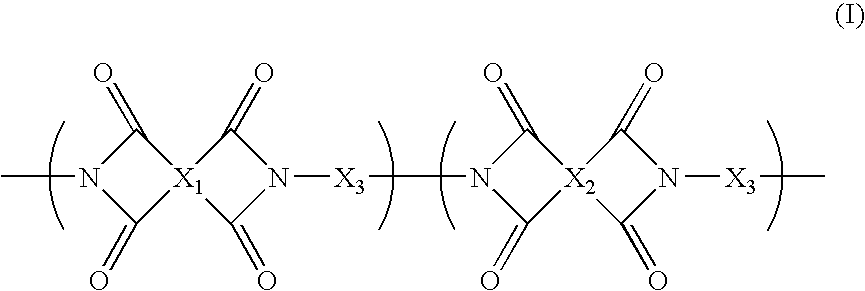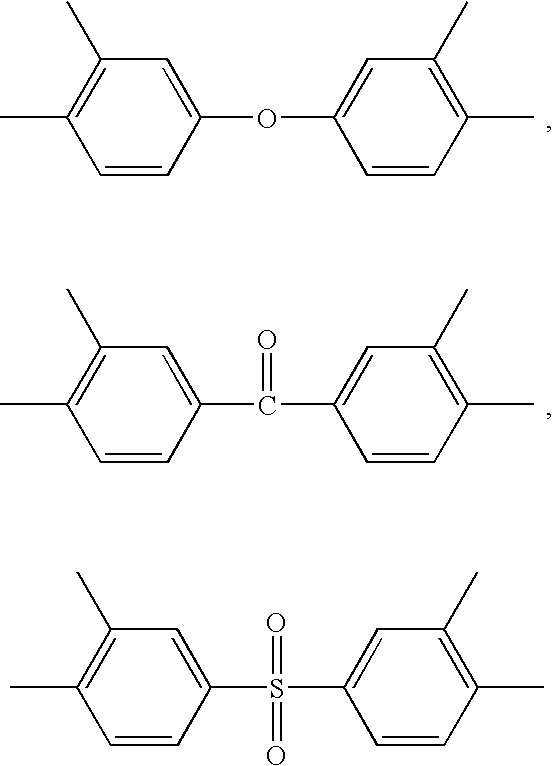Polymer Membranes Prepared from Aromatic Polyimide Membranes by Thermal Treating and UV Crosslinking
a polymer membrane and aromatic polyimide technology, applied in the field of polymer membranes prepared from aromatic polyimide membranes by thermal treatment and uv crosslinking, can solve the problems of thermal stability and contaminant resistance limitations of traditional polymer membranes, and the selectiveness of polymers which are more permeable is generally less, so as to improve the selectivity and permeability of gas, and the effect of high selectivity
- Summary
- Abstract
- Description
- Claims
- Application Information
AI Technical Summary
Benefits of technology
Problems solved by technology
Method used
Image
Examples
example 1
Synthesis of poly(BTDA-APAF)polyimide
[0050]An aromatic poly[3,3′,4,4′-benzophenonetetracarboxylic dianhydride-2,2-bis(3-amino-4-hydroxyphenyl)-hexafluoropropane] (poly(BTDA-APAF)) polyimide containing UV cross-linkable carbonyl groups and pendent —OH functional groups ortho to the heterocyclic imide nitrogen in the polymer backbone was synthesized from 2,2-bis(3-amino-4-hydroxyphenyl)-hexafluoropropane diamine (BTDA) and 3,3′,4,4′-benzophenonetetracarboxylic dianhydride (APAF) in NMP polar solvent by a two-step process involving the formation of the poly(amic acid) followed by a solution imidization process. Acetic anhydride was used as the dehydrating agent and pyridine was used as the imidization catalyst for the solution imidization reaction. For example, a 250 mL three-neck round-bottom flask equipped with a nitrogen inlet and a mechanical stirrer was charged with 10.0 g (27.3 mmol) of APAF and 40 mL of NMP. Once the APAF was fully dissolved, a solution of BTDA (8.8 g, 27.3 mmol...
example 2
Preparation of poly(BTDA-APAF) polyimide polymer membrane
[0051]The poly(BTDA-APAF) polyimide polymer membrane was prepared as follows: 4.0 g of poly(BTDA-APAF) polyimide synthesized in Example 1 was dissolved in a solvent mixture of 12.0 g of NMP and 12.0 g of 1,3-dioxolane. The mixture was mechanically stirred for 2 h to form a homogeneous casting dope. The resulting homogeneous casting dope was allowed to degas overnight. The poly(BTDA-APAF) polymer membrane was prepared from the bubble free casting dope on a clean glass plate using a doctor knife with a 20-mil gap. The membrane together with the glass plate was then put into a vacuum oven. The solvents were removed by slowly increasing the vacuum and the temperature of the vacuum oven. Finally, the membrane was dried at 200° C. under vacuum for at least 48 hours to completely remove the residual solvents to form poly(BTDA-APAF) polymer membrane (abbreviated as BTDA-APAF membrane).
example 3
Preparation of New Polymer Membrane from BTDA-APAF Membrane by Thermal Treatment and UV Crosslinking
[0052]The BTDA-APAF membrane prepared in Example 2 was thermally heated from 500 to 450° C. at a heating rate of 5° C. / min under N2 flow. The membrane was hold for 1 h at 450° C. and then cooled down to 50° C. at a heating rate of 5° C. / min under N2 flow. The heat-treated BTDA-APAF membrane was then exposed to UV radiation using 254 nm wavelength UV light generated from a UV lamp with 1.9 cm (0.75 inch) distance from the membrane surface to the UV lamp and a radiation time of 20 minutes at 50° C. The UV lamp that was used was a low pressure, mercury arc immersion UV quartz 12 watt lamp with 12 watt power supply from Ace Glass Incorporated. The heat-treated and then UV crosslinked new membrane was abbreviated as BTDA-APAF-HT-UV membrane.
PUM
| Property | Measurement | Unit |
|---|---|---|
| temperature | aaaaa | aaaaa |
| temperature | aaaaa | aaaaa |
| distance | aaaaa | aaaaa |
Abstract
Description
Claims
Application Information
 Login to View More
Login to View More - R&D
- Intellectual Property
- Life Sciences
- Materials
- Tech Scout
- Unparalleled Data Quality
- Higher Quality Content
- 60% Fewer Hallucinations
Browse by: Latest US Patents, China's latest patents, Technical Efficacy Thesaurus, Application Domain, Technology Topic, Popular Technical Reports.
© 2025 PatSnap. All rights reserved.Legal|Privacy policy|Modern Slavery Act Transparency Statement|Sitemap|About US| Contact US: help@patsnap.com



